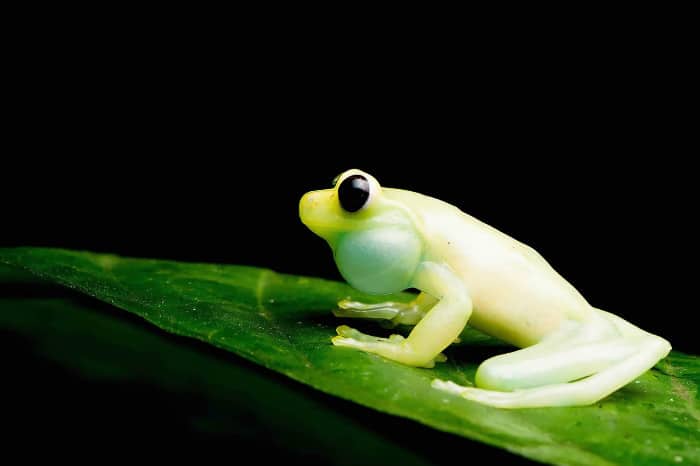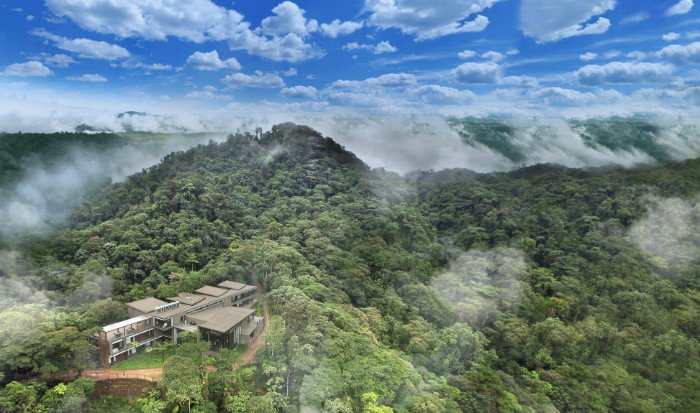A new inhabitant of the Mashpi Reserve in heart of the Equatorial Chocó Bio-Region has been recently added to the already-diverse list of fascinating wildlife that can be spotted in that region: the Mashpi Torrenteer (Hyloscirtus mashpi), a new species of tree frog, is the latest discovery of Mashpi Lodge‘s Resident Research Director, Carlos Morochz. We’ve spoken with Carlos to find out more about his exciting discovery.
How and where did you discover the Mashpi Frog?
Six years ago while doing nocturnal photography and surveys in different streams of Mashpi, I took a picture of what I thought it was a species known to science, Hyloscirtus alytolilax. After one year we decided to make a proposal of having terrariums to make exhibitions of the species of amphibians that live at Mashpi so I showed some pictures to a frog expert Luis Coloma. At the beginning he told me that it was the species that I thought it was, but once he visited the reserve he knew it was something different and that further research was needed.

The newly-discovered treefrog species at Mashpi Lodge, Mashpi Torrenteer (Hyloscirtus mashpi).
How did you identify the frog as a new species?
Once we knew it was a different frog we needed to study its morphology, behaviour, population, and we took some specimens to do some molecular analyses to compare with its closest relative species. There were many differences like its size, its colour – it has a black stripe on its back – its vocalisations and of course its family tree after the molecular analysis told us that this species was new to science.
Can you tell us a bit about what you know about the frog? How is it different to other species in the area?
The genus Hyloscirtus is part of the diverse tree frog family Hylidae, and represents a conspicuous component of the anuran fauna in the Andean foothills and cloud forests. This genus currently contains 34 recognised, extant species, all of which reproduce in streams. Most of the species in the Hyloscirtus genus have relatively narrow distributions and are restricted to specific microhabitats (i.e. mountain streams) and climatic niches (the cool, moist environments near streams). Only three species of the H. bogotensis group are known to occur on the Pacific lowlands and/or Andean Pacific slopes of Colombia and/or Ecuador; these species are: H. alytolylax, H. palmeri and H. simmonsi. Individuals of H. mashpi n. sp. are almost identical to H. alytolylax and only two morphological traits are useful (although partially overlapping) to differentiate the two taxa; H. mashpi n. sp. has a smaller body size , and a dorsum that usually shows a conspicuous mid-dorsal stripe (stripe usually absent in H. alytolylax). The two species are readily differentiated in terms of vocalisations; H. mashpi n. sp. has a short call with only 2 or 3 notes; in contrast, H. alytolylax has a longer call with 5–8 notes. Additionally, the two species seem to have allopatric distributions, with H. mashpi n. sp. being found at lower elevations (778–1279m) than H. alytolylax (1510–1858 m).
H. mashpi n. sp. can be distinguished from H. palmeri mainly by having a noticeably smaller, non-overlapping body size , mid-dorsal stripe usually present (absent), foot webbing pale yellowish-green (orange) and by lacking a heel cal-car . In Ecuador, H. mashpi n. sp. and H. palmeri have overlapping elevational ranges, and have been found in sympatry in one locality.
Finally, when comparing H. mashpi n. sp. to its sister species , H. simmonsi differs by having four notes in all recorded calls and longer, non-overlapping call duration than H. mashpi n. sp. . Also, H. simmonsi is a larger species, and is only known from the Pacific flank of Andes in Colombia at elevations of 1100–2000 m.

Mashpi Lodge is located in Ecuador’s Chocó Bio-Region
Tell us how the frog survives in the Andean Cloud Forest?
H. mashpi n. sp. is currently known only from localities on the western slopes of the Ecuadorian Andes, Pichincha province, at elevations between 778 and 1279 m, H. mashpi n. sp. is a nocturnal species restricted to riverine vegetation in primary evergreen foothill forests. In this ecosystem, the frog perches on leaves and branches 30–400 cm above ground/stream level, and is active under a variety of climatic conditions. At Reserva de Biodiversidad Mashpi (Riachuelo Laguna), it is the most abundant stream amphibian. The species seems to reproduce opportunistically during the whole year. At Riachuelo Laguna, tadpoles are abundant in flat areas with water accumulation, where they forage at the rocky bottom. At Reserva de Biodiversidad Mashpi, sympatric species include: (i) Riachuelo Laguna: Espadarana prosoblepon, Hypsiboas picturatus, Pristimantis achatinus, P. labiosus, P. latidiscus and P. luteolateralis.
How did it feel to know that you had discovered a brand new species, never before discovered?
I think is every biologist dream! I felt that passion and effort never has to end, there are many more species undescribed yet to Ecuador and specialy in the Chocó region where nothing is left 5% or less and is one of the least know cientifically explore and protected region. We are just starting I think many new surprises will come.
Find out more about the Mashpi Reserve on one of our Ecuador adventures. You can download a brochure here or contact us to start building your personalised Ecuador adventure.

